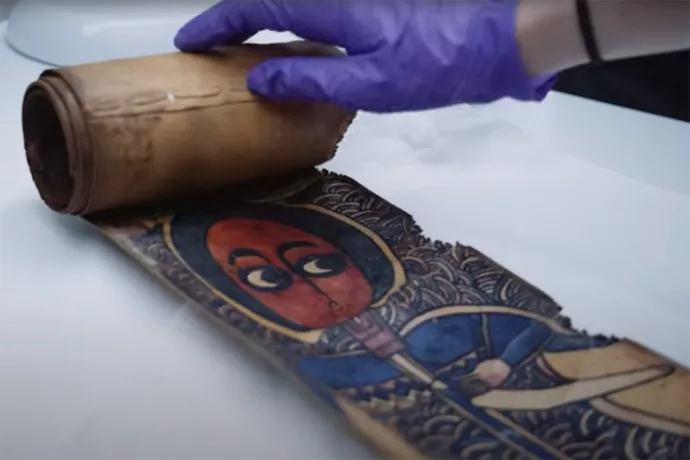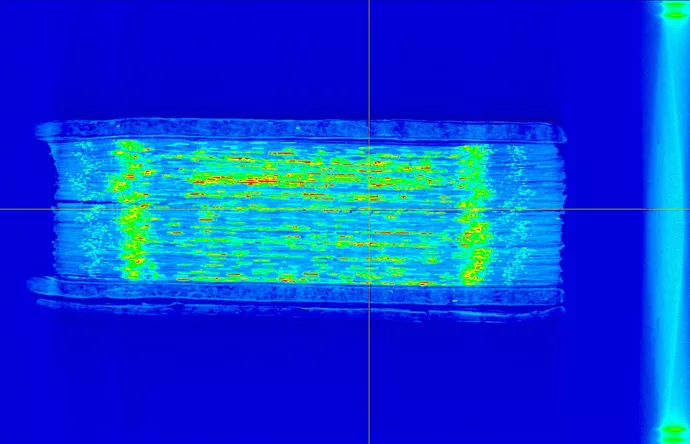
Hidden stories: Researchers use technology to uncover ‘invisible’ tales from ancient books in new exhibit
An ancient book can tell a story in more ways than one.
The wood on its cover can tell stories about the climate of the years it lived. MicroCT scans can highlight parts that can’t be seen by the naked eye. Its paper and ink can reveal technologies that were used at that point in history.
And from now until Feb. 27, 2022, the Aga Khan Museum – organized in collaboration with the University of Toronto – is revealing these stories and many others at its exhibit Hidden Stories: Books Along the Silk Roads.
“It’s truly a feast for the eyes,” says Alexandra Gillespie, vice-president and principal of UTM. “When you go into the exhibit, you immediately start seeing objects that begin telling you a story about the transnational nature of the production of books in the pre-modern period.”
The Aga Khan Museum has partnered with The Book and the Silk Roads project, which is an Andrew W. Mellon Foundation-funded project driven by the Old Books New Science (OBNS) Lab at UTM, the Institute for Advanced Study (IAS) in Princeton, and University of Toronto Libraries’ Information Technology Services (ITS).
The exhibit will also have a digital companion site, hosted by the University of Toronto Libraries’ ITS department.
Gillespie, who is the principal investigator with The Book and the Silk Roads project and director of the OBNS, says the exhibit will include ancient artifacts such as books, robes, scrolls, and textiles that reveal how these objects shaped and documented life along one of history’s most important trade networks.
“We use the word ‘book’ to mean any kind of text-bearing object,” Gillespie explains, adding that the exhibit shows “conversations that are occurring between these objects.”
For example, visitors will see decorative elements that were meant to make books look beautiful – just as objects such as rugs and robes were made to look beautiful.
The exhibit partly tells “the story of the book as a craft . . . as a made object,” says Gillespie.
In addition to the artifacts, Gillespie says the exhibit will also show visitors 3D MicroCT scans of books under non-destructive X-ray, which were conducted by the University of Toronto and Western University in collaboration with the Ontario Museum of Archaeology and St. Joseph’s Health Centre in London, Ontario.
Gillespie says the MicroCT scans can reveal fascinating stories about a manuscript’s history that couldn’t otherwise be seen – for example, craft technologies of the past.
Rachel Di Cresce, digital project librarian at the ITS department and the project librarian for U of T’s The Book and the Silk Roads project, says the exhibit’s digital companion site also includes MicroCT scans of some of the artifacts that are on display in-person.
One of those artifacts is a Book of Hours known as Canon Grandel’s Prayer Book, which was made in 15th century France and was added to the exhibition by Western University's Archives and Special Collections. Scans of the book reveal empty sewing holes and other traces of the original medieval binding, which was removed more than 300 years ago when the book was rebound with its current cover.
“We know at some point the book was taken apart. We have kind of lovingly referred to it as a ‘ghost binding’ because when it visually pops up in a scan, it looks a little ominous. And you can see that there's traces that the bookmakers have actually left behind. There’s some greater story to be told there that we don't fully know yet,” Di Cresce says.
She adds that the digital exhibit will also have interesting features including an interactive map, videos exploring key exhibition objects, an audio track of a chant song from a 16th century Spanish choir book, and a zoom-in function to view exquisitely detailed manuscript paintings.

Online exhibit visitors will also be able to see some of the same items on display at the museum in a digital format, including items from U of T’s Thomas Fisher Rare Book Library, the Western University’s Archives and Special Collections, the Aga Khan Museum, the Royal Ontario Museum (ROM), and the Marshall and Marilyn Wolf Collection.
U of T’s Thomas Fisher Rare Book Library has loaned a diverse selection of historical codices, pothi books, and scrolls from Turkey, Ethiopia, Egypt, Tibet, and Nepal, and ranging in date from the 11th to the 20th centuries.
“It’s quite an extensive collection,” Di Cresce says.
Whether visitors attend the exhibit online or in-person, Gillespie says they will be surprised by the beauty of these objects – including a 17th-19th century manuscript containing the Hindu Bhagavad Gita, on loan from U of T’s Thomas Fisher Rare Book Library.
“The beauty really shines from them,” Gillespie says. “We often think of books as utilitarian objects designed to carry a text ... but these are also objects of extraordinarily exquisite craft, of amazing human ingenuity.”
